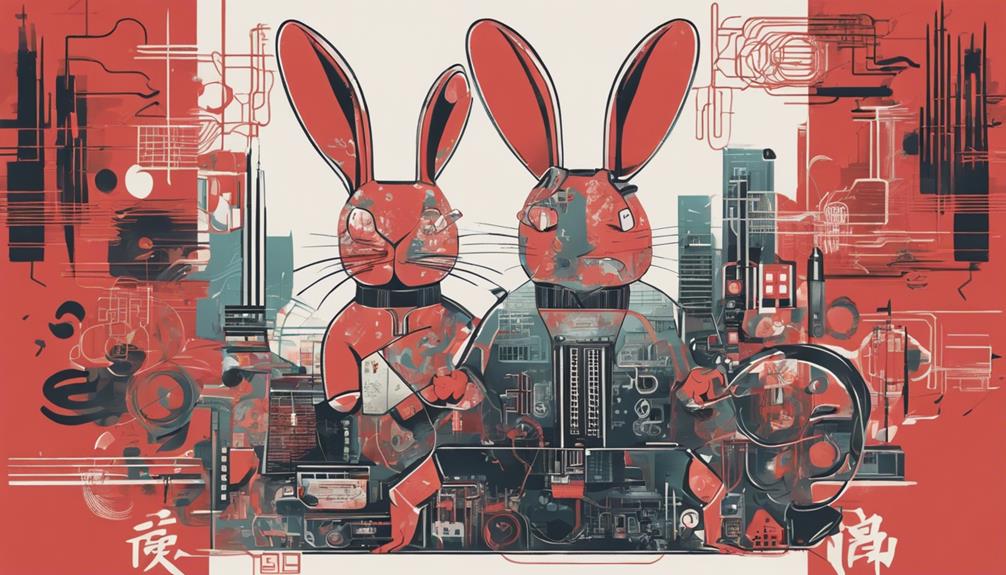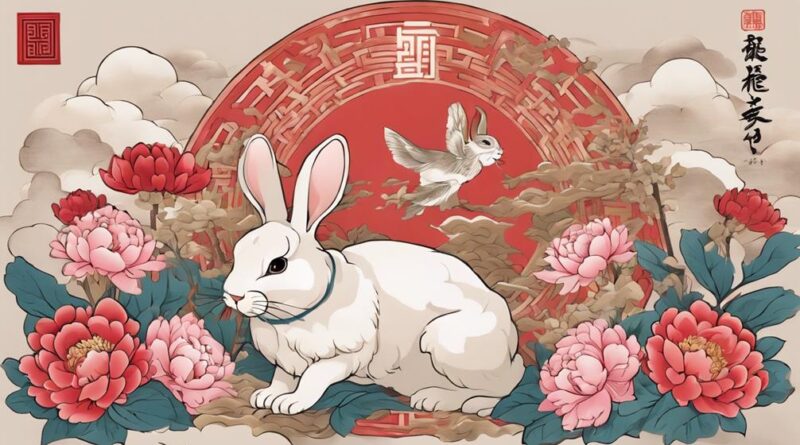7 Tips: Understanding Rabbit Symbolism in Chinese Art
To comprehend rabbit symbolism in Chinese art, grasp their representation of selflessness and luck. Chinese folklore associates rabbits with sacrifice and good fortune. Those born in the Year of the Rabbit embody gentleness and compassion. Symbolizing prosperity and immortality, rabbits are seen in various art forms as symbols of longevity and abundance. In Chinese paintings, rabbits convey messages of longevity, beauty, and spiritual harmony. The intricate details in these depictions highlight the cultural heritage and beliefs surrounding rabbits. Each stroke captures a layer of meaning, offering profound insights into Chinese values and traditional symbolism.
Historical Significance of Rabbits in Art
When exploring the historical significance of rabbits in art, one can't overlook their pervasive presence in various cultures throughout the centuries. These creatures have played a significant role in the artistic evolution of societies worldwide, influencing a myriad of art forms from paintings to sculptures.
Rabbits have been a common subject in art dating back to ancient times, symbolizing different aspects based on cultural influence. In European art, rabbits often represented fertility and rebirth due to their prolific nature. Artists would incorporate rabbits into their works to convey themes of new beginnings and the cycle of life.
In contrast, in Japanese art, rabbits were often associated with the moon due to the folklore of a rabbit residing on the moon, pounding mochi. This cultural influence led to the portrayal of rabbits in serene moonlit scenes, symbolizing tranquility and beauty.
Moreover, in African art, rabbits were sometimes depicted as tricksters in folk tales, showcasing a different facet of their cultural significance. This portrayal highlighted the cunning and resourcefulness of rabbits, adding depth to their representation in art.
Symbolism of Rabbits in Chinese Culture
Rabbits hold a significant symbolic role in Chinese culture, embodying various virtues and beliefs that have permeated art, folklore, and traditions for centuries. In Chinese folklore tales, rabbits are often associated with the Moon. The story of the Jade Rabbit pounding medicine in the Moon Palace is well-known, symbolizing selflessness and sacrifice. This tale reflects the Chinese values of kindness and service to others. Moreover, rabbits are believed to be a sign of longevity and immortality in Chinese culture due to the connection with the elixir of life.
In Chinese zodiac meanings, the Rabbit is the fourth animal sign. People born under this sign are considered to be gentle, kind-hearted, and compassionate. They're believed to have a refined taste and a love for beauty. This symbolism extends to the idea of harmony and peace, as rabbits are seen as creatures that avoid conflict. Those born in the Year of the Rabbit are thought to bring good luck and fortune.
Different Representations of Rabbits in Art
In artistic expressions, rabbits are often depicted symbolizing fertility, agility, and abundance, showcasing their diverse representations in various forms of art. Cultural interpretations play a significant role in shaping these artistic expressions.
In Chinese art, rabbits are commonly associated with the Moon, emphasizing tranquility and wisdom. The rabbit's representation in painting and calligraphy reflects these cultural beliefs, with delicate strokes capturing the essence of grace and elegance.
Artistic expressions of rabbits in Chinese art go beyond paintings and calligraphy. Sculptures often depict rabbits alongside other symbols to convey messages of prosperity and longevity. For instance, a rabbit seen with peaches symbolizes immortality, while a rabbit with a mortar and pestle signifies the elixir of life. These representations highlight the interconnectedness of rabbits with luck and good fortune in Chinese culture.
Furthermore, rabbits are portrayed in various mediums such as ceramics, where their playful and lively nature is captured through intricate designs and vibrant colors. These artistic representations not only showcase the creativity of the artists but also serve as a visual narrative of the cultural significance attached to rabbits in Chinese art.
In essence, the different representations of rabbits in Chinese art provide a glimpse into the rich tapestry of cultural interpretations and artistic expressions that have endured through centuries, making rabbits a timeless and revered symbol in Chinese artistic traditions.
The Connection Between Rabbits and Luck
Luck intertwines with the symbolism of rabbits in Chinese art, reflecting a profound cultural belief in the auspicious nature of these creatures. When exploring the connection between rabbits and luck, it's essential to delve into various aspects such as rabbit folklore, superstitions, and the significance of rabbits in the zodiac.
- Rabbit Folklore and Superstitions: Throughout Chinese history, rabbits have been associated with good fortune and prosperity. Folklore often portrays rabbits as clever and resourceful animals, symbolizing intelligence and quick-thinking. Superstitions surrounding rabbits include beliefs that encountering a rabbit before an important event brings good luck, or that keeping a rabbit's foot as an amulet wards off evil spirits.
- Rabbit Zodiac Characteristics: In the Chinese zodiac, the Rabbit is the fourth animal in the twelve-year cycle. People born in the Year of the Rabbit are believed to possess gentle and compassionate personalities. They're often seen as diplomatic, elegant, and well-mannered individuals. The Rabbit zodiac sign is also associated with creativity and a keen sense of intuition.
- Symbolism in Art: When rabbits are depicted in Chinese art, their presence isn't merely decorative but laden with symbolism. Artists use rabbits to convey messages of abundance, longevity, and family unity. The portrayal of rabbits in various art forms serves as a visual representation of the positive attributes and blessings associated with these animals in Chinese culture.
Interpretation of Rabbit Motifs in Paintings
Exploring the intricate symbolism woven into Chinese paintings, one can unravel the profound significance behind the inclusion of rabbit motifs. In Chinese art, the depiction of rabbits carries a myriad of cultural interpretations and artistic influences. Rabbits are often associated with the Moon in Chinese culture, symbolizing longevity, immortality, and feminine beauty. This connection stems from the mythical associations where the Moon Palace is said to be inhabited by a jade rabbit pounding medicine. The rabbit's presence in paintings can thus represent a harmonious blend of natural elements and spiritual beliefs.
Artistic influences further enrich the interpretation of rabbit motifs in Chinese art. The delicate brushstrokes used to capture the essence of rabbits showcase the skill and craftsmanship of the artist. The portrayal of rabbits amidst serene landscapes or alongside figures in traditional attire reflects the attention to detail and narrative depth in these artworks. Additionally, the symbolic meanings attributed to rabbits, such as cleverness, agility, and abundance, add layers of complexity to the overall message conveyed in the paintings.
In essence, the interpretation of rabbit motifs in Chinese paintings goes beyond mere visual representation. It delves into a world where cultural heritage, artistic expression, and symbolic significance converge to create timeless pieces that continue to captivate viewers with their beauty and meaning.
Impact of Rabbits on Traditional Chinese Art
The presence of rabbit motifs in Chinese art has significantly influenced the traditional artistic expressions, shaping the cultural narrative and aesthetic value of these creations. This cultural influence can be seen through various aspects of traditional Chinese art:
- Symbolism: Rabbits are often depicted in Chinese art to symbolize fertility, longevity, and prosperity. These motifs not only add symbolic meaning to the artwork but also reflect the values and beliefs held in Chinese culture.
- Artistic Techniques: The inclusion of rabbits in traditional Chinese art pieces has led to the development of intricate artistic techniques. Artists pay meticulous attention to detail when portraying rabbits, showcasing their skills and mastery of the craft.
- Cultural Heritage: The integration of rabbits in Chinese art has become an integral part of the country's cultural heritage. These motifs have been passed down through generations, preserving the rich history and traditions of Chinese artistic expression.
The artistic expression found in traditional Chinese art, influenced by the cultural significance of rabbits, serves as a testament to the deep-rooted connections between art and culture. The intricate designs, symbolic meanings, and historical significance of rabbit motifs continue to captivate audiences and contribute to the enduring legacy of Chinese art.
Modern Adaptations of Rabbit Symbolism

Amidst the evolution of artistic expression, contemporary artists have reimagined the symbolism of rabbits in innovative ways, infusing new perspectives into the traditional cultural motifs. Contemporary interpretations of rabbit symbolism in Chinese art have been greatly influenced by cultural shifts and modern societal values. Artists today are exploring the symbolic meanings of rabbits beyond the traditional associations of luck, fertility, and auspiciousness.
In modern adaptations, rabbits are often depicted in art as symbols of agility, cleverness, and adaptability, reflecting the fast-paced nature of contemporary life. These representations speak to the resilience and quick thinking required to navigate the complexities of the modern world. Additionally, rabbits are now being portrayed in art with a focus on their role as companions and sources of comfort, emphasizing themes of companionship and emotional support.
The artistic evolution of rabbit symbolism also reflects changing attitudes towards the environment and wildlife conservation. Contemporary artists use rabbits to symbolize the delicate balance of nature and the need for environmental preservation. By incorporating these themes into their work, artists are bringing attention to pressing issues and advocating for a more sustainable relationship with the natural world.
Frequently Asked Questions
What Is the Significance of Rabbit Symbolism in Chinese Astrology?
In Chinese astrology, the Rabbit zodiac holds significant symbolism, especially within the Lunar calendar. Representing compassion, creativity, and sensitivity, those born under this sign are believed to be kind-hearted and artistic individuals.
The Rabbit's association with the Moon also links it to intuition and harmony. People under this zodiac are often seen as empathetic and peaceful, embodying qualities that resonate with the lunar cycles and the natural world.
Are There Any Specific Colors Associated With Rabbits in Chinese Art?
In Chinese art, specific colors associated with rabbits hold symbolic meanings. White rabbits symbolize purity and innocence, while black rabbits represent mystery and elegance. Brown rabbits often signify harmony with nature, and gray rabbits are linked to wisdom and intelligence.
Various rabbit breeds are depicted in artistic representations, each carrying unique connotations. Understanding the color symbolism and rabbit breeds in Chinese art can deepen your appreciation for the intricate meanings behind these representations.
How Do Rabbits Symbolize Family and Fertility in Chinese Culture?
Rabbits symbolize strong family bonds and fertility in Chinese culture. They represent harmonious relationships within families and the abundance of offspring. These adorable creatures are often seen as a symbol of unity, love, and prosperity within the family unit.
In Chinese art, rabbits are depicted to convey the importance of family ties and the blessings of fertility, making them revered symbols in various artistic representations.
Can Rabbits Represent Different Emotions or Personalities in Art?
In art, rabbits can convey a range of emotional expressions and personality traits. Through artistic interpretations, these creatures symbolize various characteristics like agility, cleverness, and innocence.
Their depiction can evoke feelings of playfulness, curiosity, or even vulnerability. Artists use rabbits to represent different emotions and personalities, adding depth and complexity to their works.
Do Different Breeds of Rabbits Hold Varying Symbolic Meanings in Chinese Art?
Different breeds of rabbits indeed hold varying symbolic meanings in Chinese art. Breed symbolism in art can reflect cultural variations and beliefs.
For example, the Angora rabbit may symbolize luxury and elegance due to its soft fur, while the Netherland Dwarf could represent innocence and purity because of its small size. Understanding these breed-specific symbols adds depth and richness to the interpretation of Chinese artwork.
Conclusion
In conclusion, understanding rabbit symbolism in Chinese art reveals a rich history and cultural significance. From representing luck and prosperity to being a symbol of longevity and rebirth, rabbits have played a prominent role in traditional Chinese art.
By exploring the different representations and interpretations of rabbits in paintings, one can gain a deeper appreciation for the complexities and depth of symbolism in Chinese art.
The impact of rabbits continues to be seen in modern adaptations, showcasing the enduring relevance of these iconic symbols.
